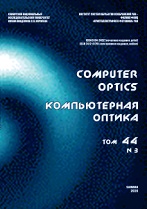|
This article is cited in 4 scientific papers (total in 4 papers)
DIFFRACTIVE OPTICS, OPTICAL TECHNOLOGIES
Can the radial number of vortex modes control the orbital angular momentum?
A. V. Volyara, E. G. Abramochkinb, M. V. Bretskoa, Ya. E. Akimovaa, Yu. A. Egorova
a V. I. Vernadsky Crimean Federal University, Simferopol
b Samara Branch of P. N. Lebedev Physical Institute, Russian Academy of Sciences
Abstract:
In general, a standard Laguerre-Gauss (LG) beam, whose state is given by two quantum numbers $(n,~\ell)$: the radial number $n$ and the azimuthal number $\ell$ (or the topological charge (TÑ) of the vortex carried by the LG beam), is unstable with respect to weak perturbations. This is not difficult to see if we decompose the complex amplitude of the LG beam in terms of Hermite-Gauss modes (HG), with the total number of HG modes being equal to $N=2n+\ell+1$. If we now slightly change the amplitudes and phases of each HG mode, then the structure of the LG beam radically changes. Such a combination of modes is called a structured LG beam (sLG), which can carry large additional arrays of information embedded in the sLG beam by encoding the amplitudes and phases of the HG modes (excitation of modes). But as soon as a perturbation is inserted into the LG beam, its orbital angular momentum (OAM) can change dramatically in such a way that the value of the OAM changes in the interval $(–\ell,~\ell)$, and the total TC – in the interval $(–2n–\ell,~2n+\ell)$. At $n=0$, the OAM changes smoothly in the interval $(–\ell,~\ell)$, however it is worth "turning on" the radial number $n$, as the OAM oscillations occur. The number of minima (maxima) of the oscillations is equal to the radial number $n$ in the interval $\theta=(0,~\pi)$ and $\theta=(\pi,~2\pi)$, with their amplitude nonlinearly depending on the difference $\ell–n$, except for the point $\theta=\pi$, where the structured beam becomes degenerate. If $\ell=0$, then the OAM is zero, so that in the sLG beam structure, we observe either a symmetrical array of vortices with opposite-sign TCs or a pattern of edge dislocations, the number of which is equal to the radial number $n$. We also found that, despite the fast oscillations of the OAM, the absolute value of the total TC of the sLG beam does not change with variation of both the amplitude $\varepsilon$ and phase $\theta$ parameters, but depends solely on the initial state $(n,~\ell)$ of the LG beam and modulo $(2n+\ell)$.
Keywords:
structural stability, topological charge, orbital angular momentum, vortex spectrum
Received: 01.06.2022
Accepted: 12.07.2022
Citation:
A. V. Volyar, E. G. Abramochkin, M. V. Bretsko, Ya. E. Akimova, Yu. A. Egorov, “Can the radial number of vortex modes control the orbital angular momentum?”, Computer Optics, 46:6 (2022), 853–863
Linking options:
https://www.mathnet.ru/eng/co1078 https://www.mathnet.ru/eng/co/v46/i6/p853
|

| Statistics & downloads: |
| Abstract page: | 15 | | Full-text PDF : | 6 |
|




 Contact us:
Contact us: Terms of Use
Terms of Use
 Registration to the website
Registration to the website Logotypes
Logotypes







 Citation in format
Citation in format 
